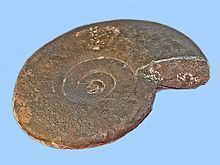Rank Genus Subclass Ammonites | Superfamily Ceratitaceae | |
 | ||
Similar Ammonites, Monophyllites, Ceratitida, Paraceratites, Cladiscites | ||
How to pronounce gymnites
Gymnites is a genus of ammonoid cephalopod from the Middle Triassic belonging to the ceratitid family Gymnitidae. These nektonic carnivores lived during the Triassic period, Anisian age.
Contents
Description
The shell of Gymnites is evolute, generally smooth, with a wide umbilicus. Whorls are moderately embracing, whorl section oval and somewhat compressed. The outer whorl may be costate or have rows of nodes, or both. The suture is ammonitic with a wide bifurcated ventral lobe and two lateral lobes on either side.
Taxonomic relation
Hyatt and Smith (1905, p. 115)included Gymnites in the Gymnitidae along with Ophiceras, Flemingites, and Xenaspis, genera since assigned elsewhere, and included the Gymnitidae in the suborder Ceratitoidea (now the superfamily Ceratitaceae). Smith (1932, p. 30) shows Gymenites derived from Xenaspis and giving rise to the Pinacoceratidae.
The American Treatise (Part L, 1957) also includes Gymnites in the Gymnitidae, along with mainly descendant forms such as Buddhaites, Japonites, and variations on Gymnites itself, but instead included the Gymnitidae in the Pinacocerataceae which is consistent with Smith's derivation of the Pinacoceratidae from Gymnites.
Distribution
Fossils of species within this genus have been found in the Triassic of Afghanistan, Canada, China, Hungary, Iran, Russia, Switzerland, Turkey, United States.
